2007 GMC SIERRA CLASSIC reset
[x] Cancel search: resetPage 352 of 674
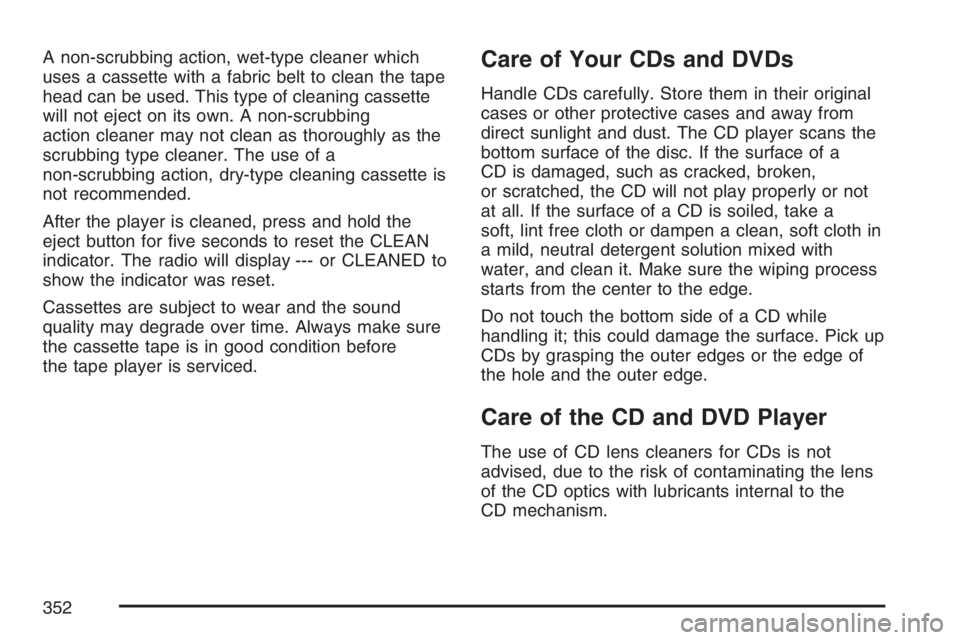
A non-scrubbing action, wet-type cleaner which
uses a cassette with a fabric belt to clean the tape
head can be used. This type of cleaning cassette
will not eject on its own. A non-scrubbing
action cleaner may not clean as thoroughly as the
scrubbing type cleaner. The use of a
non-scrubbing action, dry-type cleaning cassette is
not recommended.
After the player is cleaned, press and hold the
eject button for �ve seconds to reset the CLEAN
indicator. The radio will display --- or CLEANED to
show the indicator was reset.
Cassettes are subject to wear and the sound
quality may degrade over time. Always make sure
the cassette tape is in good condition before
the tape player is serviced.Care of Your CDs and DVDs
Handle CDs carefully. Store them in their original
cases or other protective cases and away from
direct sunlight and dust. The CD player scans the
bottom surface of the disc. If the surface of a
CD is damaged, such as cracked, broken,
or scratched, the CD will not play properly or not
at all. If the surface of a CD is soiled, take a
soft, lint free cloth or dampen a clean, soft cloth in
a mild, neutral detergent solution mixed with
water, and clean it. Make sure the wiping process
starts from the center to the edge.
Do not touch the bottom side of a CD while
handling it; this could damage the surface. Pick up
CDs by grasping the outer edges or the edge of
the hole and the outer edge.
Care of the CD and DVD Player
The use of CD lens cleaners for CDs is not
advised, due to the risk of contaminating the lens
of the CD optics with lubricants internal to the
CD mechanism.
352
Page 461 of 674

Power Take-Off (PTO)
Before using a Power Take-Off (PTO), if equipped,
refer to the manufacturer’s or installer’s instructions.
To engage a PTO on a vehicle with a manual
transmission do the following:
1. Hold the clutch pedal down.
2. Set the parking brake.
3. Shift the transmission into NEUTRAL.
4. Engage the PTO. Refer to the manufacturer’s
or installer’s for instructions on electrically
engaged PTOs.
5. For mobile operations, shift the transmission
into the gear you want, apply the regular
brakes and release the parking brake.
For stationary operations, leave the parking
brake applied.
6. Release the clutch and regular brakes as you
normally would. When the clutch is released,
the PTO will start.
7. Turn the PTO rotary switch to ON.To engage a PTO on a vehicle with an automatic
transmission do the following:
1. For stationary use shift the transmission into
PARK (P).
2. Turn the PTO rotary switch ON.
3. If the engine speed is below the PTO engage
speed limit, the PTO will start. The blinking
LED on the PTO control switch indicates PTO
engage is requested. When PTO engages the
LED will switch from blinking to a steady light.
To use PTO speed control in Preset Mode (Factory
Setting) do the following:
1. Engage the PTO.
2. Select PARK (P) or NEUTRAL (N) range.
Apply the parking brake if NEUTRAL (N) is
selected. Torque Converter Clutch (TCC)
is not available in NEUTRAL (N) and is
available only in PARK (P) when engine speed
is above 1,100 rpm.
3. Make sure your foot is off the brake pedal
(and off the clutch on vehicles equipped
with a manual transmission).
4. Select the desired engine speed for PTO
operation. Read the following preset mode
information regarding operation.
461
Page 462 of 674
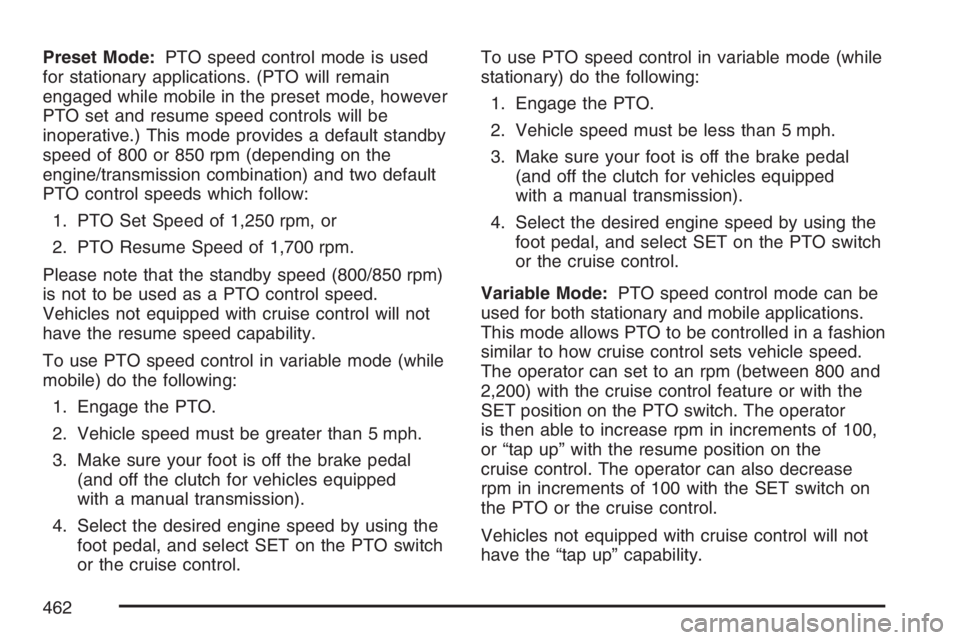
Preset Mode:PTO speed control mode is used
for stationary applications. (PTO will remain
engaged while mobile in the preset mode, however
PTO set and resume speed controls will be
inoperative.) This mode provides a default standby
speed of 800 or 850 rpm (depending on the
engine/transmission combination) and two default
PTO control speeds which follow:
1. PTO Set Speed of 1,250 rpm, or
2. PTO Resume Speed of 1,700 rpm.
Please note that the standby speed (800/850 rpm)
is not to be used as a PTO control speed.
Vehicles not equipped with cruise control will not
have the resume speed capability.
To use PTO speed control in variable mode (while
mobile) do the following:
1. Engage the PTO.
2. Vehicle speed must be greater than 5 mph.
3. Make sure your foot is off the brake pedal
(and off the clutch for vehicles equipped
with a manual transmission).
4. Select the desired engine speed by using the
foot pedal, and select SET on the PTO switch
or the cruise control.To use PTO speed control in variable mode (while
stationary) do the following:
1. Engage the PTO.
2. Vehicle speed must be less than 5 mph.
3. Make sure your foot is off the brake pedal
(and off the clutch for vehicles equipped
with a manual transmission).
4. Select the desired engine speed by using the
foot pedal, and select SET on the PTO switch
or the cruise control.
Variable Mode:PTO speed control mode can be
used for both stationary and mobile applications.
This mode allows PTO to be controlled in a fashion
similar to how cruise control sets vehicle speed.
The operator can set to an rpm (between 800 and
2,200) with the cruise control feature or with the
SET position on the PTO switch. The operator
is then able to increase rpm in increments of 100,
or “tap up” with the resume position on the
cruise control. The operator can also decrease
rpm in increments of 100 with the SET switch on
the PTO or the cruise control.
Vehicles not equipped with cruise control will not
have the “tap up” capability.
462
Page 463 of 674

All engine speed values listed above are factory
preset values. With the exception of the TCC
lockup speed (1,100 rpm) and the “tap” increment
(100 rpm), all of these values are programmable
and can be adjusted by your dealer or body
up�tter. If the PTO software settings do not match
the settings shown here, then they may have
already been altered in order to satisfy the
requirements of the installed PTO system and
body equipment.
When the PTO switch is turned on, the engine is
limited to 2,200 rpms. If there are no accessories
installed on the vehicle, make sure the PTO switch
is turned off.Step-Bumper Pad
Your vehicle has a rear step bumper with a rear
step pad at the center of the bumper.
If you will be using the
bumper to tow a trailer,
and your step-bumper
has three cutout circles,
you must push out the
center cutout circle to
install the trailer ball.
If your step-bumper has only one cutout circle,
you will have to cut out the circle, then remove it to
install the trailer ball.
463
Page 489 of 674
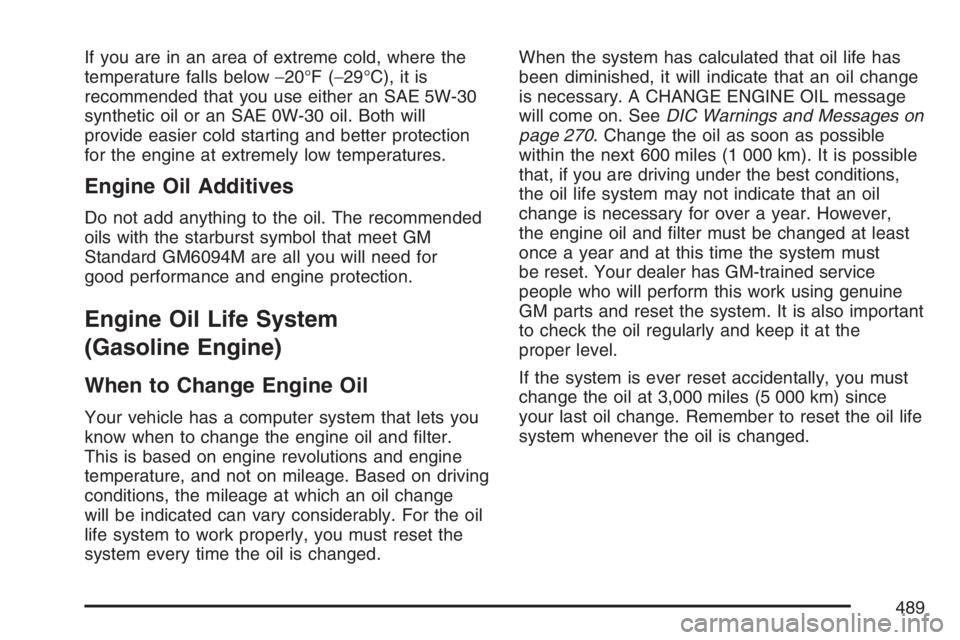
If you are in an area of extreme cold, where the
temperature falls below−20°F (−29°C), it is
recommended that you use either an SAE 5W-30
synthetic oil or an SAE 0W-30 oil. Both will
provide easier cold starting and better protection
for the engine at extremely low temperatures.
Engine Oil Additives
Do not add anything to the oil. The recommended
oils with the starburst symbol that meet GM
Standard GM6094M are all you will need for
good performance and engine protection.
Engine Oil Life System
(Gasoline Engine)
When to Change Engine Oil
Your vehicle has a computer system that lets you
know when to change the engine oil and �lter.
This is based on engine revolutions and engine
temperature, and not on mileage. Based on driving
conditions, the mileage at which an oil change
will be indicated can vary considerably. For the oil
life system to work properly, you must reset the
system every time the oil is changed.When the system has calculated that oil life has
been diminished, it will indicate that an oil change
is necessary. A CHANGE ENGINE OIL message
will come on. SeeDIC Warnings and Messages on
page 270. Change the oil as soon as possible
within the next 600 miles (1 000 km). It is possible
that, if you are driving under the best conditions,
the oil life system may not indicate that an oil
change is necessary for over a year. However,
the engine oil and �lter must be changed at least
once a year and at this time the system must
be reset. Your dealer has GM-trained service
people who will perform this work using genuine
GM parts and reset the system. It is also important
to check the oil regularly and keep it at the
proper level.
If the system is ever reset accidentally, you must
change the oil at 3,000 miles (5 000 km) since
your last oil change. Remember to reset the oil life
system whenever the oil is changed.
489
Page 490 of 674
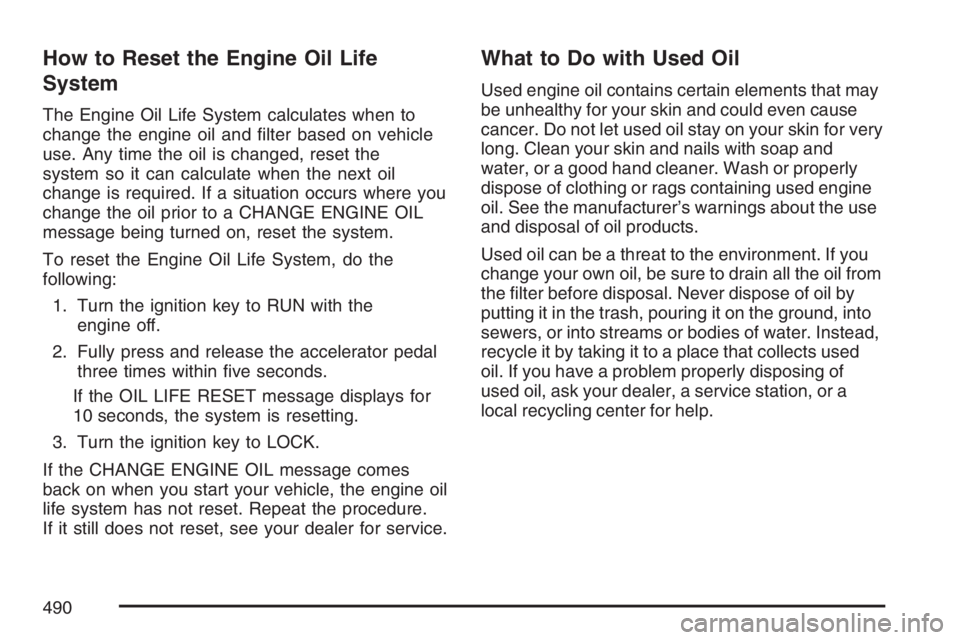
How to Reset the Engine Oil Life
System
The Engine Oil Life System calculates when to
change the engine oil and �lter based on vehicle
use. Any time the oil is changed, reset the
system so it can calculate when the next oil
change is required. If a situation occurs where you
change the oil prior to a CHANGE ENGINE OIL
message being turned on, reset the system.
To reset the Engine Oil Life System, do the
following:
1. Turn the ignition key to RUN with the
engine off.
2. Fully press and release the accelerator pedal
three times within �ve seconds.
If the OIL LIFE RESET message displays for
10 seconds, the system is resetting.
3. Turn the ignition key to LOCK.
If the CHANGE ENGINE OIL message comes
back on when you start your vehicle, the engine oil
life system has not reset. Repeat the procedure.
If it still does not reset, see your dealer for service.
What to Do with Used Oil
Used engine oil contains certain elements that may
be unhealthy for your skin and could even cause
cancer. Do not let used oil stay on your skin for very
long. Clean your skin and nails with soap and
water, or a good hand cleaner. Wash or properly
dispose of clothing or rags containing used engine
oil. See the manufacturer’s warnings about the use
and disposal of oil products.
Used oil can be a threat to the environment. If you
change your own oil, be sure to drain all the oil from
the �lter before disposal. Never dispose of oil by
putting it in the trash, pouring it on the ground, into
sewers, or into streams or bodies of water. Instead,
recycle it by taking it to a place that collects used
oil. If you have a problem properly disposing of
used oil, ask your dealer, a service station, or a
local recycling center for help.
490
Page 492 of 674
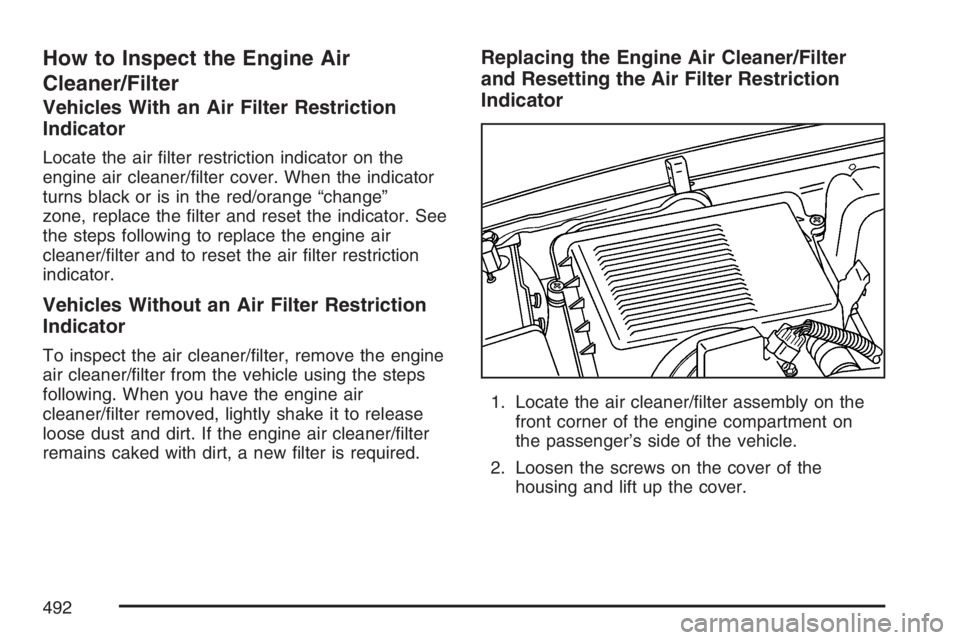
How to Inspect the Engine Air
Cleaner/Filter
Vehicles With an Air Filter Restriction
Indicator
Locate the air �lter restriction indicator on the
engine air cleaner/�lter cover. When the indicator
turns black or is in the red/orange “change”
zone, replace the �lter and reset the indicator. See
the steps following to replace the engine air
cleaner/�lter and to reset the air �lter restriction
indicator.
Vehicles Without an Air Filter Restriction
Indicator
To inspect the air cleaner/�lter, remove the engine
air cleaner/�lter from the vehicle using the steps
following. When you have the engine air
cleaner/�lter removed, lightly shake it to release
loose dust and dirt. If the engine air cleaner/�lter
remains caked with dirt, a new �lter is required.
Replacing the Engine Air Cleaner/Filter
and Resetting the Air Filter Restriction
Indicator
1. Locate the air cleaner/�lter assembly on the
front corner of the engine compartment on
the passenger’s side of the vehicle.
2. Loosen the screws on the cover of the
housing and lift up the cover.
492
Page 493 of 674
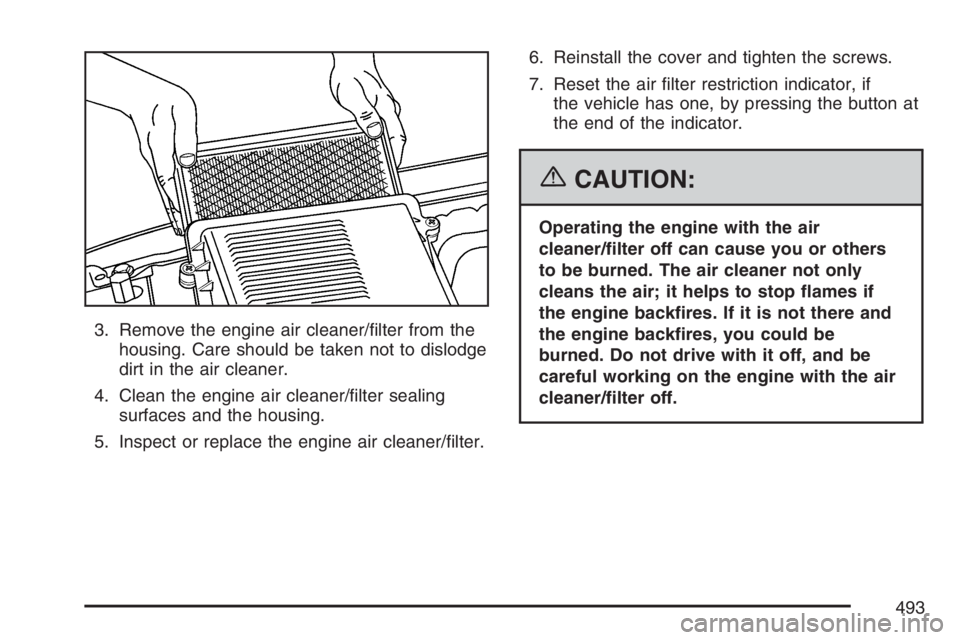
3. Remove the engine air cleaner/�lter from the
housing. Care should be taken not to dislodge
dirt in the air cleaner.
4. Clean the engine air cleaner/�lter sealing
surfaces and the housing.
5. Inspect or replace the engine air cleaner/�lter.6. Reinstall the cover and tighten the screws.
7. Reset the air �lter restriction indicator, if
the vehicle has one, by pressing the button at
the end of the indicator.
{CAUTION:
Operating the engine with the air
cleaner/�lter off can cause you or others
to be burned. The air cleaner not only
cleans the air; it helps to stop �ames if
the engine back�res. If it is not there and
the engine back�res, you could be
burned. Do not drive with it off, and be
careful working on the engine with the air
cleaner/�lter off.
493